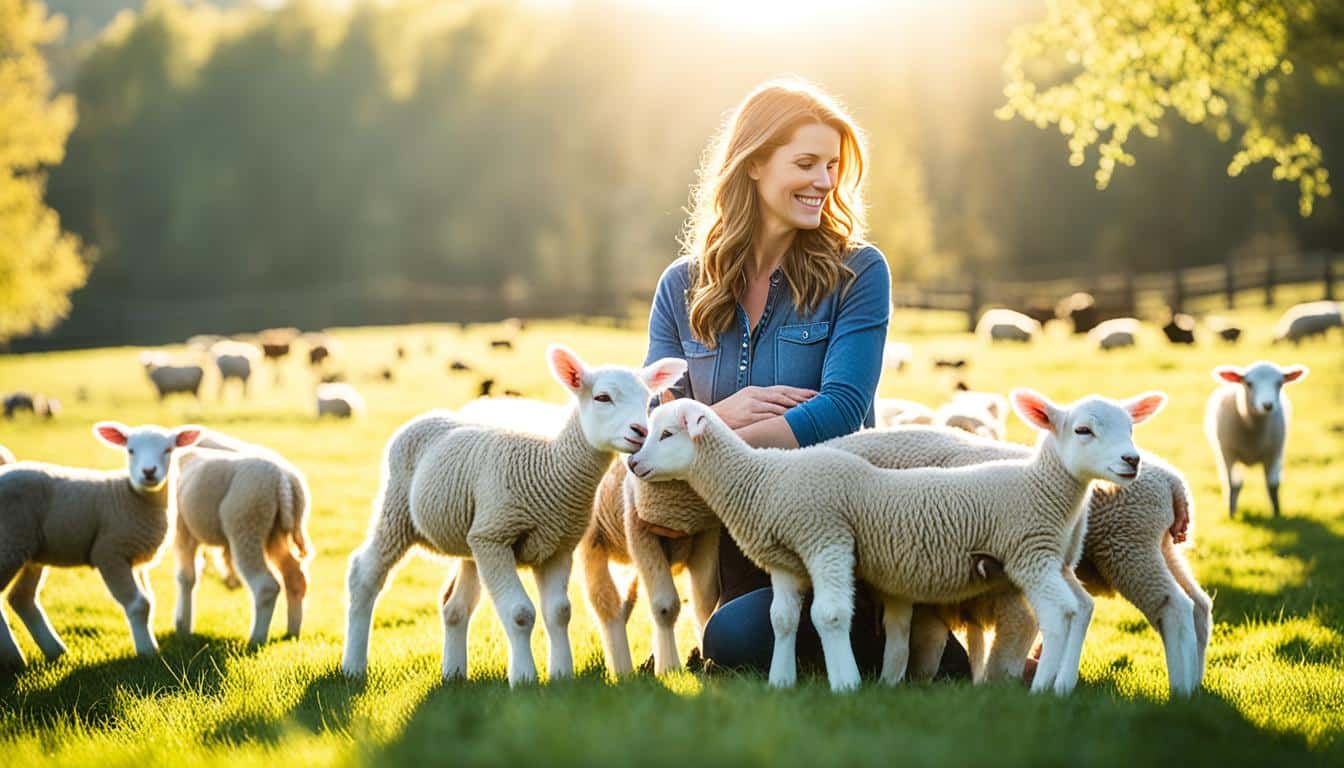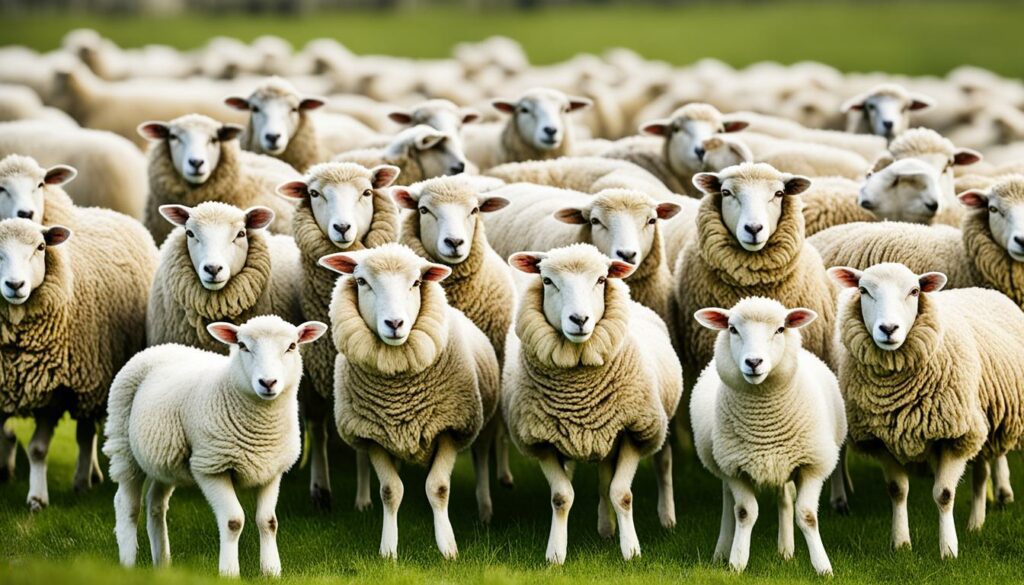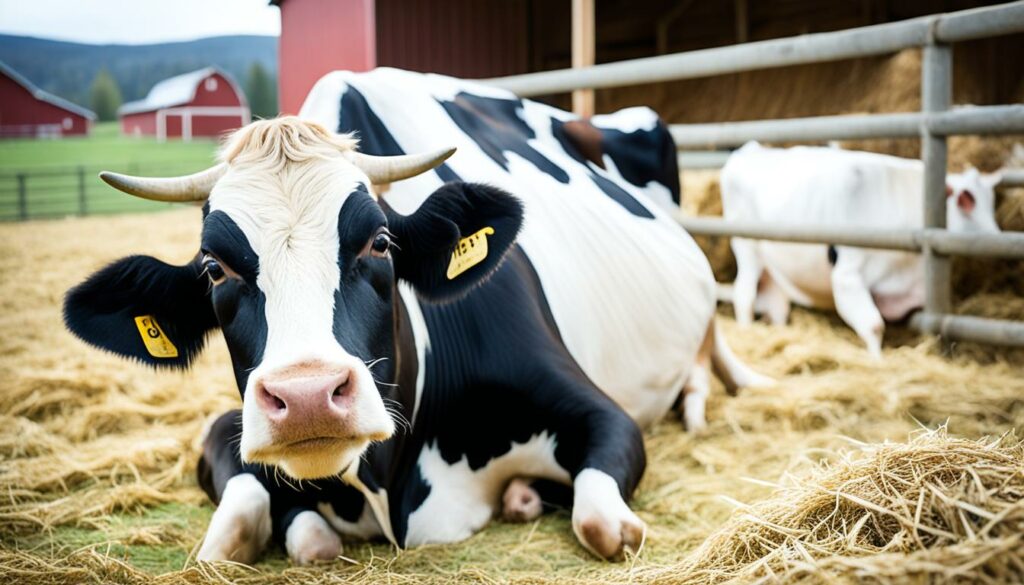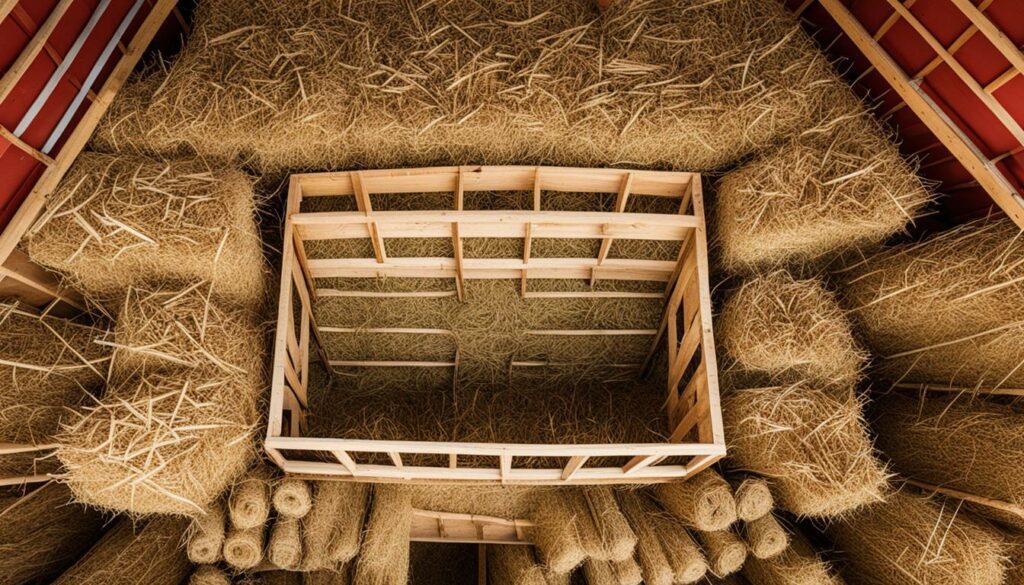Menu

About half of the beef industry’s yearly losses come from calf deaths due to difficult births. This issue makes a good plan for the spring calving season vital. As spring nears, setting up a detailed calving strategy helps keep the herd healthy. It also makes calving less stressful for the cows and boosts the efficiency of the season’s tasks.
Reproductive success is key in managing livestock. The success and profit of beef farming are heavily reliant on it. Its value is seen as 10 times more valuable than production and 20 times greater than the product itself. For this reason, careful planning for calving and preparing for the birthing season are essential parts of agricultural breeding and livestock care.
Getting calving facilities ready is key for a successful spring. This involves cleaning barns and setting up the right pens. It’s crucial for keeping the animals healthy during and after birth.
To avoid sickness and keep births safe, barns must be kept clean. Make sure to:
These steps are crucial for livestock health and wellness during calving. The barns need to be clean, and they shouldn’t have been used for at least 10 months to prevent diseases.
Calving pens need to be big and easy to reach. This way, it’s quick to help if needed. It’s important to think about:
For spring calving, paying close attention to the setup is a must. These steps, like ensuring enough space and cleanliness, help everyone involved. They improve the chances of everything going smoothly during calving season.
| Aspect | Consideration |
|---|---|
| Fence Inspection | Repair and secure all fencing. |
| Debris Clearing | Remove obstacles to ensure safety. |
| Ventilation | Check and maintain proper ventilation systems. |
| Lighting | Adequate lighting for visibility and safety. |
| Heating | Ensure heating systems are functioning correctly. |
Calving season is crucial for cow-calf farms. 90% see its big role in livestock management. Preparation should begin four weeks before calving. This includes getting essential supplies for different birth situations.

Good animal husbandry means being ready with obstetrical supplies. This includes:
OB lubricant is key for a smooth birth. Nearly 70% agree it’s a must-have in any calving kit.
Nutrition is vital after birth. Calves need high-quality colostrum in 6 hours. They should get 2 to 4 quarts. Electrolytes and other supplements boost their health.
Emergencies during calving need special tools. This includes:
Every farm’s needs may vary. So, customise your toolkit to suit your situation.
| Calving Supply Category | Recommended Items | Importance |
|---|---|---|
| Obstetrical | Gloves, OB chains, Iodine | Immediate birthing support |
| Nutritional | Colostrum, Electrolytes | Post-birth health |
| Emergency | Calf puller, Resuscitator | Critical care |
Use a detailed checklist for essential calving supplies. Know the key parts of calving season preparation. It helps manage possible issues, keeping cows and calves healthy.
It’s vital to feed pregnant cows right for their health and the calf’s. Checking their progress and adjusting their diet is key.
In the last three pregnancy months, calf growth skyrockets. Cows need more protein and nutrients. Good food means easier calving and healthier calves.
Cows facing cold raise their energy needs by a lot. For each degree below 18°F, they need 1 to 2 percent more total digestible nutrients.
It’s smart to talk to a vet about what pregnant cows should eat. Vets know how to meet the cows’ needs. They make sure cows get enough energy and protein, especially when it counts most. In the final two trimesters, cows eat about 2 to 2.5% of what they weigh on the dry matter basis.
Good feed and hay are vital for keeping a herd healthy. To ensure cows’ health in tough weather, maintaining a score of 5 to 6 is important. This is done by giving them the right nutrition.
Corn residue is a great feed source at various stages of pregnancy. It has different levels of protein and digestibility, making it useful throughout.
| Feed Component | Percentage | Crude Protein | Digestibility |
|---|---|---|---|
| Grain | 45.9% | 9.5-11.2% | 88-95% |
| Leaf | 11.5% | 6.2-7.5% | 43-48% |
| Husk | 7.0% | 2.6-3.8% | 57-64% |
| Cob | 8.2% | 2.1-3.8% | 32-38% |
| Stalk | 27.5% | 3.0-5.1% | 43-50% |

Setting up a herd health plan is vital, especially with spring livestock birthing approaching. It’s key to do thorough health checks and keep a tight vaccination schedule. This helps the herd have top immunity exactly when it’s most needed.
Vaccines work best a few weeks after being given, but their effectiveness drops over time. So, it’s crucial to vaccinate cows against reproductive diseases at least seven to eight months before they breed. Yet, giving certain vaccines to pregnant cows could lead to risks like abortions. Always check with a vet to avoid these problems.
Vaccines against diseases like Bovine Viral Diarrhoea (BVD), Infectious Bovine Rhinotracheitis (IBR), vibriosis, and leptospirosis are essential to boost the herd’s strength. Among them, the BOVILIS® NASALGEN® 3-PMH vaccine is outstanding. It protects against the main causes of pneumonia, offering complete support.
During fall pregnancy checks, it’s a good time to catch up on any missed vaccinations and parasites control. Vaccinating against scours five to seven weeks before calving boosts the mother’s colostrum. This helps newborn calves by giving them important antibodies.
Just after birth, managing colostrum well is crucial. Every calf needs two quarts within two hours of being born. Then, another two quarts within the next four hours. This helps them absorb the antibodies. Adding BOVILIS® GUARDIAN® to the plan further protects calves from scours.
Following these careful farming practices builds a solid base for the spring livestock birthing period. Plus, it means healthier and more productive animals all year round.
It’s vital to keep an eye on calving so livestock are well managed. Knowing when a cow is in labour and using tech to watch them helps a lot. This way, you can step in when needed, which makes calving better.
Spotting the signs of labour means we can help at the right time. Cows might seem uneasy, want to be alone, and their body temperature might drop. They might also have a big belly and leak colostrum, says Berglund and others in 1987.
According to Troxel and Gadberry in 2012, cows often start calving when the air pressure rises and the temperature falls. Delaying help during birth’s second stage can make cows take longer to get pregnant again. It can also lower pregnancy rates in the future, as found by Doornbos and others in 1984.
| Study | Key Observation |
|---|---|
| Jaeger et al., 2008 | Evening feeding increases daylight calving. |
| Troxel and Gadberry, 2012 | Calving onset follows specific ambient conditions. |
| Doornbos et al., 1984 | Delays in assistance prolong pregnancy intervals. |
| Bellows et al., 1988 | Early assistance improves estrus cycles and pregnancy rates. |
| Lombard et al., 2007 | Dystocia affects calf health and survival. |
Tech makes calving supervision more effective and safe. Remote monitoring, like with cameras, is praised by Palombi and team in 2013. Borchers and colleagues in 2017 say smart tools that learn from cows’ behaviours help a lot.
Mounting cameras lets you watch without being there. You can help quicker and better, making newborns healthier and helping them grow faster, as seen by Bellows and others in 1988.
So, combining tech with knowing the signs of labour is key to successful calving and looking after the animals.
Spring birthing is key to farming. It requires good planning to have a successful calving season. Practising optimal birthing helps cows have healthy calves in the right season.
It’s best if calves are born in a 45 to 90-day window. This timing means ranchers can manage better and calves grow well. It also helps sell calves at better prices because they’re all about the same age.

Cows should be in top shape, scoring seven in body condition, when they give birth. This makes them more likely to have an easy time and be fertile. Spring calving is good because grass is plentiful. This makes calves bigger and saves on feed costs.
The right choice of season depends on the farm’s goals. Summer calving suits those who raise cows on grass because it’s abundant. Fall calving can be more profitable, according to the University of Tennessee. This depends on the study
Winter calving has its challenges, needing more resources. March is usually better for profits than May. This shows the importance of timing.
Getting the calving season right can make a big difference. A 60-90 day period is best, not too short or long. It helps with managing food and prices. Changing to a set season from year-round calving can be budget-friendly over three years.
Having some cows calve in spring and others in fall can be smart. It helps manage risks and adjust to changes in the weather.
Good planning and management are must-haves for a successful calving season. By setting a good birth cycle, farmers can earn more and keep their animals healthy.
Efficient birthing relies heavily on keeping precise records and tracking due dates. It’s crucial to gather detailed data for managing fertility well. This directly affects how profitable the herd will be. Keeping detailed calving records helps in making smart decisions during the birthing season.
Using Key Performance Indicators (KPIs) is key to accurately monitor fertility performance. These include calving dates, heat dates, and pregnancy diagnosis dates. They help collect a big picture of the fertility data. Timely diagnosing of pregnancy is important for accurate fertility measurement.
Today, computer-based systems are the best way to keep up with KPIs. They beat manual methods because they’re faster and more detailed. They are supported by programs such as LPA, CATTLECARE, and the MSA scheme. These tools stress the need for good records. Using CuSum graphs can make it easier to see trends in your data. This visual guide helps in quick reproductive performance checks.
Now, computers are vital for keeping records due to their efficiency. They allow creating summaries with details on all animals in the herd. This includes their age and gender. These summaries are helpful for keeping track of changes in your herd numbers. They clue you in on births, purchases, losses, and feed needs.
Having a plan for managing your herd each month is also crucial. This could be a table or a circular planner, depending on your needs. For trading livestock, it’s important to have a record of the animals at the start of the year. This is a must for good bookkeeping.
| Livestock Information | Details |
|---|---|
| Calving Dates | January – December |
| Heat Dates | Recorded as they occur |
| Service Dates | After heat detection |
| Pregnancy Diagnosis Dates | 14-21 days after service |
| Results and Birth Outcomes | Recorded post-calving |
To sum up, organised record-keeping and sticking to due dates makes birthing more efficient. Good records help you watch over the fertility performance. They also point out where you can make your herd management better. This leads to a stronger farm.
Giving the cow and calf good care after birth is key. This ensures their health and well-being. I work hard to look after them properly, using the best advice in animal care. I’ll show you what’s important and how to handle things after the birth.

Watching the cow’s health after birth is crucial. We look for any signs of problems and make sure she’s eating and drinking well.
When a calf is born, quick actions can save its life. Knowing how to help a just-born calf is very important.
Good techniques include:
What we do right after a calf is born matters a lot. We need to take care of it properly, which includes:
Getting everything ready before birth is very important. I make sure we have all we need and think about what might happen. This way, we can look after the cow and calf well as soon as they are born. Doing all these things right improves our chances of a successful calving season.
Effective training and sharing knowledge are key for a successful spring birthing season. Training all involved well enhances calving help and animal care. Everyone must know the rules to work together smoothly during birth.
Training everyone involved is essential for spring birthing. Staff training helps them learn important skills and work better together. They should learn how to help with birthing, what to do in emergencies, and how to care for the animals every day. This makes sure everyone knows what to do, creating a strong team.
Sharing knowledge helps everyone learn and work better as a team. Talking and learning from each other leads to new ideas and better ways to do things during calving. Being open and always learning makes everyone more confident and effective. This way, all team members are ready for any problem.
These good practices have long-lasting effects. 4-H livestock projects are great for kids, teaching them to care, be responsible, and tough. Such projects teach young ones important life skills by taking care of animals like goats since they were born.
| Livestock Project Benefits | Details |
|---|---|
| Emotional and Mental Health | Providing therapeutic benefits during stressful times |
| Physical Health | Encouraging outdoor activities and physical work |
| Financial Management | Learning budgeting and fundraising skills |
| Leadership Development | Opportunities through mentoring within projects |
| Social Skills | Fostering relationships and friendships among youth and volunteers |
Taking part in these projects is not just fun but also teaches kids to be leaders and make good friends. Working with livestock helps kids grow into strong leaders, with memories they’ll cherish. It prepares them for a future working with animals.
To manage livestock effectively during birth season, you need a strong emergency plan. Most births happen smoothly, but it’s smart to get ready for surprises. When births are hard, acting early can make a big difference. Here’s your guide to a top-notch emergency plan.
Making an emergency kit is key to your plan. It should have things like:
Always make sure your kit is up to date. Check it often to keep it ready to use.

In emergencies, clear communication is crucial. A contact list ensures you can get help fast. Include:
Also, assign jobs for daily care so nothing falls behind when there’s an emergency.
Properly managing your team is vital. Make sure everyone knows how to handle daily farm tasks and emergency situations. This way, you’re all set for whatever comes your way during birth season.
Lastly, don’t forget about the market. Disasters or factory closures can hit your farm hard. Planning for this makes your farm stronger and able to face tough times.
Key to successful livestock reproduction and health is a smooth calving process. I suggest gathering calving assistance items four weeks before calving starts. Doing this keeps you ready and reduces risks.
When births are hard, a calf puller is very helpful. But, it must be used right to avoid harm. Keeping things clean after birth is vital for the cow and calf’s health.
Include essential items like gloves, lubricant, and straps in your calving kit. They help in a secure delivery. Also, have medicines ready, including a thermometer, oxytocin, and antibiotics.
Feed calves 2 to 4 quarts of colostrum within six hours of birth. This gives them vital nutrients and boosts their immunity. Always check with a vet for the best advice and medicines.
Preparing well before calving season makes things easier for agricultural breeders. Giving cows the right diet before calving enhances their and their baby’s health. Keeping a calving checklist and birth records helps in future farming practices.
| Essential Items | Purpose |
|---|---|
| Obstetrical Gloves | Maintain hygiene during calving |
| Lubricant | Assists in delivering the calf |
| Calving Jack | Helps in difficult births |
| Colostrum | Provides essential nutrients to calf |
| Thermometer | Diagnostics and monitoring |
| Oxytocin | Aids in milk let-down |
| Long-Acting Antibiotics | Prevents infections |
Keeping stress low during birthing time is key for the health of animals and people. Getting ready for calving and using good stress relief methods are very important.

To keep cows calm at calving, it helps to have a peaceful place for them and enough room in calving pens. Quick help from a vet is also crucial. Cameras can be used to check on cows without bothering them.
Studies show that making a calving kit early and talking to a vet can lead to smoother calving seasons. Many ranchers find that using special tools like OB chains and calf jacks, with advice from a vet, also makes a big difference.
Being ready for calving is a big task but very necessary. Before and after calving, some supplies are much more essential. It’s vital to stock up on medications like antibiotics and electrolytes, as well as vet-prescribed items.
Talking to a vet about medication and supplements is also crucial. Data from 2021 shows an 8% rate of hard births that need a calf jack. This makes regular talks with vets very important for a smooth calving season.
| Key Metrics | Percentage / Ratio |
|---|---|
| Producers preparing a calving kit | 72% |
| Consultation with a vet for OB chains & calf jacks | 85% |
| Usage of pre-calving vs post-calving essentials | Higher Pre-calving |
| Maintain medicine cabinet with essential items | 78% |
| Occurrence rate of difficult births needing a calf puller | 8% |
| Consultation on medications & supplements with a vet | 65% |
Efficient calving is key in animal husbandry and involves several important practices. One crucial factor is timing, with high calf prices usually in spring. This, along with spring-born calves being heavier, makes spring a great time for calving.
It’s vital to review what pregnant cows eat. The National Research Council says a 1,172-pound beef cow needs particular amounts of energy and protein daily. As it gets colder, cows need more food to stay warm. But, feeding too much can cause problems during birth.
It’s also important to set up calving areas well. Barns should be clean, have good light, and be airy. This ensures cows are comfortable and productive. Good conditions also help prevent problems in calves born in summer.
Before calving, boost vaccinations are crucial. This prevents diseases and boosts colostrum quality. Adequate shelter and ventilation are musts for birthing areas too. They set the right conditions for calving.
| Season | Calf Birth Weight | Supplemental Feed Requirements | Weaning Weight |
|---|---|---|---|
| Spring | Higher | Moderate | Higher (Except Southeast U.S.) |
| Summer | Moderate | Moderate | Lower |
| Fall | Moderate | Higher (Due to Forage Scarcity) | Moderate |
| Winter | Moderate | Higher (Due to Cold Weather Energy Needs) | Moderate |
Keep detailed records to improve farm management. Sadly, not many small farms in the US keep good records. Tracking things like calving dates and health can help a lot. A structured approach boosts farm efficiency.
To sum up, following informed farming methods for calving makes a big difference. By focusing on nutrition, preparing facilities, and keeping good records, farmers improve their practices. This leads to better productivity and healthier animals.
This guide has shown how careful planning can lead to a better calving season. With the right mix of preparation and attention, handling calving becomes smoother.
It is well-known that keeping cows at a body condition score (BCS) of 5 is better. This means 88% of cows could reproduce successfully within 75 days. It boosts profits by improving offspring weight and their prices. However, a low BCS could mean delayed reproduction and fewer profits.
Maintaining pastures well is key to keeping animals healthy. Doing soil tests, adding lime, fertilising, controlling weeds, and keeping the grass short are vital. Offering high-quality minerals for free and considering extra feeds helps keep animals healthy.
Choosing when to have calves is also important. Early spring births may cost more but can bring in more money. On the other hand, birthing later cuts down on costs and disease risks. However, it might mean lighter calves at weaning. Still, later births tend to be more cost-effective.
To sum up, a detailed plan for spring birthing pays off. It lowers worries and boosts the chances of a good calving period. Following these steps can help in achieving the best results in animal care.
A structured plan for spring calving is key. It supports herd health and makes the birthing process easier. This plan lessens stress for both animals and those taking care of them. It also improves the efficiency of the season’s logistics.
First, make sure the calving barns are clean and safe. Check the fencing and clear any debris. Also, ensure good ventilation, lighting, and heating. Calving pens should be big enough and easy to reach for quick help if needed.
Have a checklist ready with items like OB gloves, chains, iodine, and calving medications. This ensures you’re ready for different birthing situations.
Evaluate what pregnant cattle need, especially those still growing. It’s crucial to get advice from a vet for the right feeding plans. This helps keep enough good feed and hay through the winter.
Before spring calving, stick to a health plan with check-ups and vaccines. This is important for identifying cows needing extra care during birth.
Knowing the signs and stages of labour helps with on-time help. Using cameras or other tech can make checking on pregnant cows easier and safer.
Keep careful records of each cow’s due date and health. Notes on past calving problems are also important. This information helps with decisions during the birthing time.
After the birth, watch the cow’s health closely. Learn how to help a calf if they need it. This ensures both are healthy after birth.
Teaching your team and family about birthing can make a big difference. Share knowledge on helping with births and what to do in emergencies. This helps everyone be prepared and supportive during calving.
It’s crucial to have a good emergency plan and kit ready. Everyone should know what to do. This helps tackle any sudden issues fast during calving.
Having clear guidelines for helping with calving is very important. Make sure your team knows these guidelines well. This reduces danger to the cow and calf when help is needed.
Reducing stress for everyone, including the livestock, is vital. Use techniques to lower stress and plan well. This ensures a smoother birthing season for all.
Good farming practices, such as proper nutrition and good facilities, are key. They help with animal care and increase productivity.